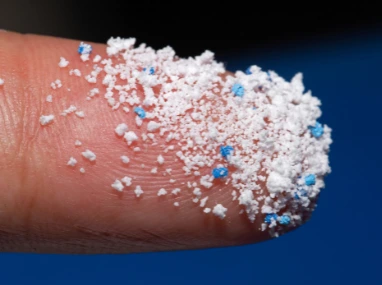A recent study, published in the journal Environmental Science & Technology Letters, has unearthed significant, and troubling, findings regarding the interaction between microplastics and cloud formation, indicating potential impacts on weather patterns.
Microplastics, tiny plastic fragments smaller than five millimeters, are ubiquitous in our environment. They originate from everyday items like clothing, packaging, and car tires. As scientific research progresses, it’s becoming evident that these microplastics aren’t only present in the atmosphere, but might also influence cloud formation.
In a notable study, researchers discovered plastic particles with water-attracting properties in clouds over Japanese mountains. Building on this, Yan Wang and his team conducted comprehensive research on Mount Tai in eastern China. They collected 28 cloud samples and analyzed them to understand the interaction between microplastics and cloud formation.
Their findings revealed a significant relationship between the amount of microplastics and cloud characteristics. Lower altitude clouds with higher density showed increased concentrations of microplastics. The microplastics identified were predominantly common polymers like polyethylene terephthalate, polypropylene, and polyethylene, typically measuring less than 100 micrometers, with some as large as 1,500 micrometers.
The study also highlighted the impact of weathered microplastics, which had higher levels of elements like lead, mercury, and oxygen on their surfaces. These elements could play a role in cloud formation, suggesting a complex interaction between microplastics and atmospheric processes.
To trace the origin of these microplastics, Wang’s team used computer modeling, which pointed to densely populated inland areas as the primary source, carried by the wind to Mount Tai. This finding contrasts with the assumption that such particles primarily come from oceans or other mountainous regions.
In laboratory settings, microplastics exposed to cloud-like conditions such as UV light and cloud-sourced water exhibited changes, becoming smaller and rougher, and accumulating more lead, mercury, and oxygen-containing groups. This transformation indicates that clouds can modify microplastics in ways that may affect both cloud formation and the distribution of airborne metals.
The implications of these findings are significant. They suggest that microplastics in the atmosphere could be playing a more active role in weather and climate systems than previously understood. As researchers continue to explore this relationship, the study underscores the need for greater awareness and action to address the pervasive issue of microplastics in our environment.
Our Analysis: How This May Affect You, The Earth, and More
The discovery that microplastics in clouds could disrupt weather patterns carries profound implications for the environment, wildlife, and the future of our planet. While it’s easy for us to type the phrase, ‘profound implications’, that doesn’t quite do it justice. So, we sat down and analyzed the data ourselves and compiled a handy list for you to better understand this complicated issue.

Impact on Global Weather Systems
Microplastics’ potential role in cloud formation could significantly alter weather patterns. Clouds play a crucial role in the Earth’s climate system, influencing temperature, precipitation, and the distribution of solar radiation. Changes in cloud formation due to microplastics could lead to unpredictable weather, altering rainfall patterns, and potentially exacerbating climate change.
Environmental Health
The presence of microplastics in clouds suggests that these particles are widespread in the atmosphere. As these plastics degrade, they release chemicals that could be harmful to the environment. Persistent organic pollutants (POPs) and other toxic substances associated with plastics might accumulate in ecosystems, affecting soil and water quality and disrupting ecological balances.
Impact on Wildlife and Biodiversity
Wildlife, both terrestrial and aquatic, could be significantly impacted by increased microplastics pollution. Microplastics can be ingested by a wide range of organisms, from plankton to larger mammals, leading to physical harm, chemical toxicity, and potential bioaccumulation of harmful substances up the food chain. This ingestion can lead to reduced fertility, growth, and survival rates in various species, posing a threat to biodiversity.
Human Health Concerns
The infiltration of microplastics into the atmosphere and the environment raises concerns about human health. Microplastics can potentially enter the human body through inhalation or consumption of contaminated food and water. While the full impact on human health is still being studied, there is growing concern about the potential for physical damage and chemical exposure.
Agricultural Implications
Changes in cloud formation and weather patterns can directly affect agriculture. Altered precipitation patterns may lead to droughts or flooding, impacting crop yields. Additionally, the deposition of microplastics on agricultural land could affect soil health and, consequently, plant growth.
Economic and Social Impact
The potential alteration of weather patterns and the direct impact on ecosystems could have significant economic and social repercussions. Agriculture, fisheries, and tourism, industries heavily reliant on predictable environmental conditions, could face challenges. This could lead to economic losses and heightened social issues, particularly in communities dependent on these industries.
Policy and Global Response
This new understanding of the impact of microplastics requires a robust global response. Policies focusing on reducing plastic pollution, improving waste management, and investing in research to better understand and mitigate the impact of microplastics are crucial. International cooperation will be key in addressing this global issue.
More To Discover
- Philippines Accuses Chinese Fishers of Cyanide Pollution in Disputed Waters
- Breakthrough Solar Cell Doesn’t Run On Sunshine: Revolutionizing Energy Storage
- Trees Are The Unexpected Climate Challengers on the Great Plains
- Self-Healing Leather Alternative from Fungi: Could It Be Mass-Produced for Sustainability?
In short, the growing presence of microplastics in the atmosphere and their potential to disrupt weather patterns presents a multifaceted challenge. It affects not just the environment but also the health of wildlife, humans, and the stability of economies reliant on predictable climatic conditions. Addressing this issue will require concerted efforts from governments, industries, and communities worldwide.



















